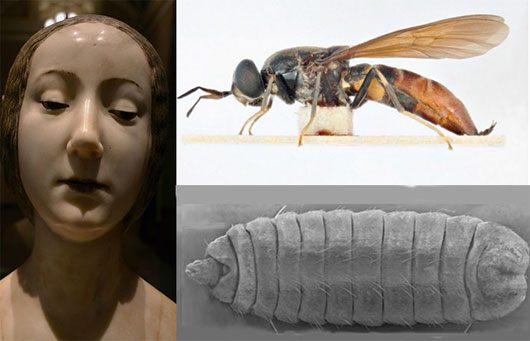The mystery of fly larvae in the remains of Italian princess
A fly larva was discovered and found in the remains of a Renaissance Italian princess, often thought to be the real prototype of the Mona Lisa in Leonardo Da Vinci painting, raising questions about the origin. The mystery of this insect.
The larvae are found in the black soldier fly , with the scientific name Hermetia illucens . This fly grows thanks to decaying organic material. For a long time, numerous researchers still believe that Hermetia illucens originated naturally in America and first appeared in Europe in the early 1990s.
"We can now prove, this insect was present in Europe many centuries earlier. In fact, we found a black soldier fly larva in the stone coffin of Princess Isabella, of Aragon (Italy), who died in 1524 " , Gino Fornaciari, professor of medical history, and an expert in ancient pathological and burial archeology at the University of Pisa (Italy), said.

The left photo is a bust depicting Princess Isabella at the Kunsthistorisches museum in Vienna, Austria.The photo must be a mature black soldier fly and its larvae.(Photo: Wikimedia Commons / Discovery)
Princess Isabella was originally the king of Naples, Alfonso II. She married her first cousin, Duke of Milan Gian Galeazzo Sforza in 1489. On this occasion, the painter Leonardo Da Vinci, who is now in charge of Milan's painter in 1482, arranged a magnificent, magnificent party with plays, robots and fountains. Some art historians claim that it is Princess Isabella and not Lisa Gherardini Del Giocondo that is the prototype for Mona Lisa in Da Vinci's paintings.
Isabella's husband has never had the right to rule, because his uncle, Ludovico, imprisoned both of them in a castle in Pavia. Princess Isabella, who once complained that her marriage was a historical misfortune, remained in Pavia until her husband died suddenly at the age of 25, possibly due to poisoning by uncle Ludovico.
Princess Isabella then returned to Naples and eventually died here at age 54, most likely due to her own syphilis medication. According to Professor Fornaciari, who participated in excavating Princess Isabella's remains, her teeth were wrapped in a thin layer of black metal. The black color of the dental coating is thought to be due to mercury, the drug Princess Isabella is prescribed in large doses, but is useless in treating her syphilis, caused.
About the two body parts of a black soldier fly larva found near the skull of Princess Isabella, Mr. Fornaciari and his colleagues said, it is highly likely that this insect has infiltrated her body for centuries. after she died. The thieves once opened the stone coffin when Princess Isabella's body was bare, making it no longer suitable for black soldier flies.
The discovery raises new questions about the origins of the black soldier fly. According to the researchers, there are three possible possibilities: First, this insect is not of American origin, but is a naturally occurring species in the Paleartic region, stretching from western Europe to the Bering Strait. , even if the residents were there until 1926, they were known.
Secondly, larvae do not belong to the Hermetia illucens, but belong to a new species, have close relatives or some mysterious species. The third hypothesis, according to Professor Fornaciari, is that the fly has migrated from the Americas to Europe in the bodies of dead mice or rotting food on Spanish merchant ships visiting Naples.
- Gorgeous tattoos on Siberian princess body
- The treasure of 2600 years reveals secrets in Celtic princess graves
- Strange discovery in the tomb of Egyptian princess
- Why do people call Italian
- Egypt discovered the tomb of a 3,700-year-old royal princess
- Increased CO2 levels threaten princess butterflies
- Found the remains of the Mona Lisa?
- The larvae are snuggled into a big tuft for self-defense
- Successful restoration of the Egyptian princess mummy
- Princess mummy 'causes earthquakes'
- The mystery of prone remains
- The mystery of the female remains is crowning in ancient thousand-year tombs in China
 Discovered an ancient centipede fossil 99 million years old
Discovered an ancient centipede fossil 99 million years old Discovered bat-like dinosaurs in China
Discovered bat-like dinosaurs in China Discovered a 200-year-old bronze cannon of the coast
Discovered a 200-year-old bronze cannon of the coast Discover 305 million-year-old spider fossils
Discover 305 million-year-old spider fossils